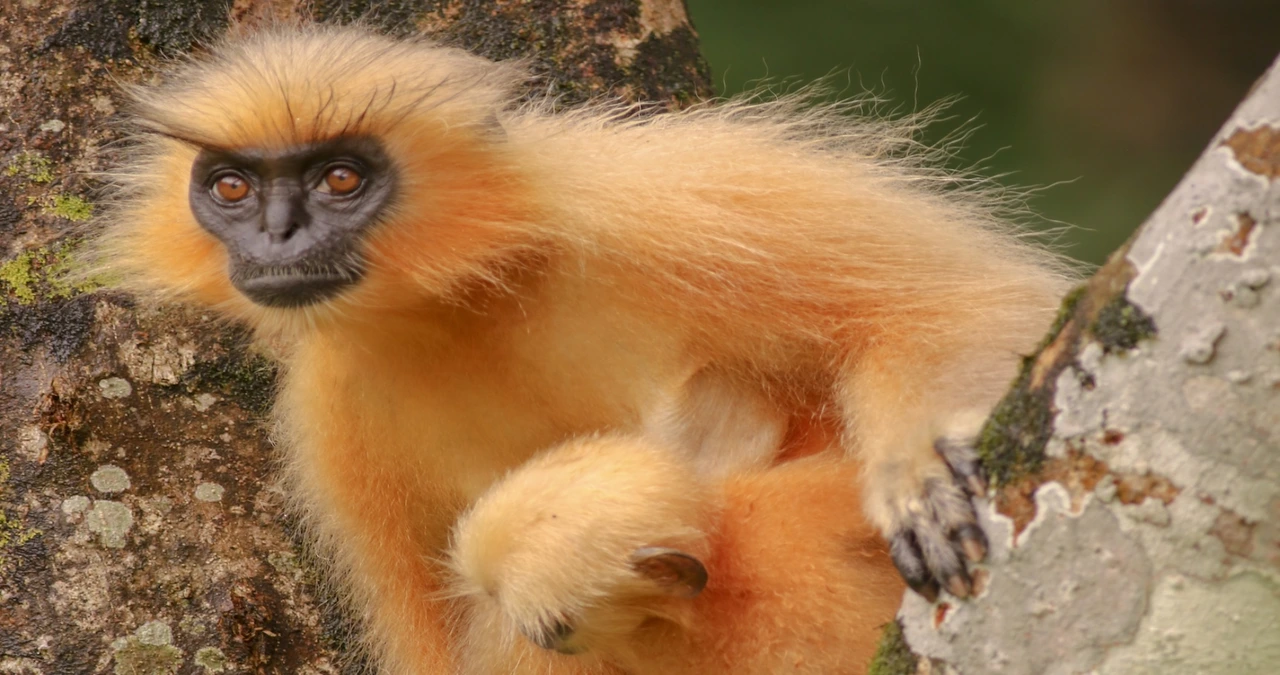Discover the fascinating world of the golden langur, its unique behavior, habitat, challenges, and conservation efforts. A rare primate that embodies the richness of Himalayan biodiversity.
Introduction to the Golden Langur
The golden langur is one of the most striking primates in the world, admired for its unique golden-orange coat that shimmers under sunlight. This rare and enchanting monkey is found mainly in the forests of Bhutan and the northeastern regions of India. Its appearance alone captures the imagination of wildlife enthusiasts, but there’s so much more to this species than its stunning looks.
What makes the golden langur even more fascinating is its symbolic value. It is not just another monkey in the forest; it represents the delicate balance of biodiversity, cultural significance, and conservation challenges. Despite its beauty, this primate faces real threats due to shrinking habitats and human activities. Understanding its life, behavior, and ecological importance helps us grasp why it has become a flagship species in the conservation world.
Physical Appearance and Distinctive Features
One cannot talk about the golden langur without marveling at its beauty. Its silky coat ranges from creamy white to a deep golden hue, depending on age, sex, and season. Sunlight reflecting on its fur creates a glowing aura, which is why locals often refer to it as a sacred being. Its black face contrasts dramatically with the bright coat, and its long tail, sometimes even longer than its body, adds grace to its movements.
Unlike some other primates, the golden langur is relatively quiet in its demeanor. Its deep-set eyes give it a wise, almost contemplative look. Adult males are slightly larger, while females and juveniles carry a lighter coat color. This golden cloak is not just for show; it provides camouflage within the lush forests, blending into the sunlit canopies. The combination of elegance and survival instinct makes the golden langur an evolutionary marvel.
Habitat and Distribution
The golden langur lives in one of the most picturesque parts of the world: the foothills of the Himalayas. Its primary range extends across Bhutan and parts of India, especially in Assam. This distribution makes it a transboundary species, dependent on cross-country conservation initiatives. The forests here are rich in tall trees, vines, and river systems, creating an ideal sanctuary.
These langurs thrive in subtropical and broadleaf forests, where food is abundant and predators are relatively scarce. The choice of habitat is not random. They prefer riverine areas and forest patches where they can feed on a wide variety of leaves, fruits, and flowers. Unfortunately, fragmentation of these habitats due to human settlement and agriculture has caused significant challenges. Today, the golden langur is considered endangered, and its once-continuous forests are now broken into smaller patches.
Social Structure and Behavior
Golden langurs are social animals, usually found in groups led by a dominant male. These groups can range from small family units to larger troops of twenty or more individuals. Their social system is built on cooperation, grooming, and hierarchy. Grooming is not just about cleanliness; it strengthens bonds within the group and reduces tension.
What’s fascinating about these langurs is their reliance on silence. Unlike other noisy primates, golden langurs communicate with subtle calls and body language. Mothers are highly protective, often carrying their infants close. Young langurs are playful, swinging from branches and testing their climbing skills under the watchful eyes of elders. The troop’s harmony and collective movement are a reminder of how order and discipline exist even in the wild.
Diet and Feeding Habits
Golden langurs are primarily folivores, meaning their diet consists mainly of leaves. However, they are also known to eat fruits, seeds, flowers, and occasionally bark. Their ability to consume a wide variety of plants makes them important for forest health, as they help in seed dispersal and maintaining ecological balance.
What’s particularly interesting is their digestive system, adapted to break down fibrous leaves. They often feed in the upper canopy, rarely descending to the ground, which reduces their risk of encountering predators. During seasonal changes, their diet shifts depending on what is available. This adaptability allows them to survive in environments where food availability fluctuates, but only as long as the forests remain intact.
Cultural and Religious Significance
The golden langur is not just a biological treasure—it holds deep cultural importance. In many parts of Assam and Bhutan, locals consider this primate sacred, often associating it with deities. Some folklore suggests that harming a golden langur brings misfortune, which historically protected the species from hunting.
Temples and monasteries near their habitats often have stories tied to these primates. The reverence given to the golden langur highlights how spirituality and ecology are intertwined. This cultural connection has played a role in conservation, reminding people that protecting nature is also about honoring traditions.
Conservation Status and Threats
Despite its sacred status and visual appeal, the golden langur is endangered. Habitat loss remains its greatest threat. Expanding agriculture, road construction, and deforestation have fragmented its once vast forest home. This isolation of groups has led to reduced genetic diversity and increased vulnerability.
Another growing threat is human-wildlife conflict. As forests shrink, langurs often raid crops, leading to tensions with farmers. Some individuals have even died due to electrocution from power lines. Poaching is relatively rare compared to other primates, thanks to its sacred status, but habitat destruction overshadows this advantage. Conservationists argue that immediate action is necessary to prevent further decline.
Conservation Efforts and Success Stories
Efforts to save the golden langur have gained momentum in recent decades. Organizations in India and Bhutan have launched awareness programs, created wildlife sanctuaries, and involved local communities in protecting habitats. Protected areas such as Chakrashila Wildlife Sanctuary in Assam serve as strongholds for the species.
Community-led initiatives have been particularly inspiring. Villagers, recognizing the cultural importance of the golden langur, have formed groups to monitor and protect them. Cross-border collaborations between India and Bhutan have also strengthened conservation strategies. While challenges remain, these collective efforts show that when culture, science, and community come together, real change is possible.
Golden Langur in Ecotourism
Ecotourism has opened up a new avenue for the golden langur’s conservation. Tourists from around the world travel to Assam and Bhutan, hoping to catch a glimpse of these majestic primates. Responsible tourism generates income for local communities while spreading awareness about the species.
However, ecotourism must be carefully managed. Overcrowding, habitat disturbance, and unethical tourism practices could harm the very species people come to admire. The key lies in promoting sustainable travel where visitors respect the langur’s space while contributing to conservation funds. Done right, ecotourism can be a win-win for both wildlife and people.
The Role of Golden Langur in Ecosystem
The golden langur plays a crucial role in maintaining forest health. As a seed disperser, it ensures the regeneration of trees and plants. Its feeding habits help regulate plant growth, maintaining a balance that benefits a wide range of species. In many ways, it acts as a silent gardener of the Himalayan forests.
Losing this species would not just be about losing a beautiful monkey. It would create a ripple effect across the ecosystem. Other animals that rely on certain plants could be affected, and the delicate biodiversity of the region could be disrupted. Protecting the golden langur is, therefore, about protecting the health of the entire forest ecosystem.
Interesting Facts about the Golden Langur
- The golden langur is one of the rarest primates in the world.
- Its fur color changes with age and season, ranging from cream to deep golden.
- It is mostly arboreal, spending its life in treetops.
- Locals in Bhutan and Assam consider it sacred.
- Unlike many monkeys, it communicates more with body language than loud calls.
These fascinating details only add to its mystery and charm. The more we learn about the golden langur, the more we realize how extraordinary it truly is.
Frequently Asked Questions (FAQs)
Q1: Where is the golden langur found?
The golden langur is mainly found in Bhutan and the northeastern state of Assam in India, especially around the foothills of the Himalayas.
Q2: Why is the golden langur endangered?
The species is endangered due to habitat loss, forest fragmentation, human-wildlife conflict, and development projects that cut through their natural range.
Q3: What does the golden langur eat?
Golden langurs are folivores, eating mostly leaves, but they also consume fruits, flowers, seeds, and bark.
Q4: Why is the golden langur sacred?
In local cultures of Assam and Bhutan, the golden langur is considered sacred and is often associated with spiritual beliefs and folklore.
Q5: How can we help in conserving the golden langur?
Supporting ecotourism, respecting wildlife sanctuaries, donating to conservation organizations, and spreading awareness about habitat protection are effective ways to help.
Conclusion
The golden langur is more than a rare primate; it is a living symbol of harmony between nature and culture. With its shimmering coat, quiet demeanor, and ecological importance, it deserves the world’s attention and protection. Conservation is not just about saving a species but about preserving an entire ecosystem and the traditions tied to it.
Safeguarding the golden langur ensures that future generations will not just read about it in books but will have the chance to witness its golden glow in the wild forests of the Himalayas.




